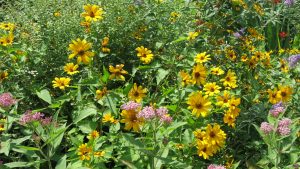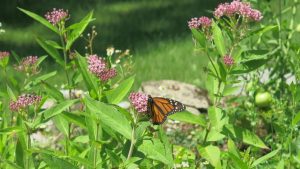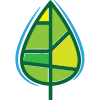Yards and gardens are a delight to the eye, sustenance for the soul, and a lifeline for pollinators.
NATIVE PLANTS
Native plants are an essential part of a sustainable yard. “Native plants have adapted to the climate, insects, and soil types found in Massachusetts.  Because of this, they may reduce the amount of pesticides, fertilizers, and water needed for a yard, as well as contribute to a more natural habitat for animals and other plants. Native plants may support 10 to 50 times as many species as non-native plants.” Ecological Landscaping Tools for Massachusetts Homeowners
Because of this, they may reduce the amount of pesticides, fertilizers, and water needed for a yard, as well as contribute to a more natural habitat for animals and other plants. Native plants may support 10 to 50 times as many species as non-native plants.” Ecological Landscaping Tools for Massachusetts Homeowners
More Resources:
- Books about habitat gardening
- Garden books by Native Plant Trust experts
- Grow Native Massachusetts Website
Trees, shrubs, and other plants are carbon sinks. They absorb carbon dioxide from the air and release oxygen that we need to breathe.
Perennials
Some favorite natives: pink-flowered swamp milkweed (Asclepias incarnata) does well in local gardens, even without a lot of watering, and so does the orange butterfly weed (Asclepias tuberosa); New England and other asters (Symphyotrichum); coneflowers (Echinacea); black-eyed susan (Rudbeckia); and many types of goldenrod (Solidago) thrive as well. Native daisy fleabane (Erigeron annuus) often invites itself into local gardens. It freely spreads by seed and needs to be watched but it is a lovely, perky little flower attractive to pollinators.

When selecting a native plant, try to purchase the “straight species” rather than a newer hybrid “named” cultivar. They are more reliably beneficial to pollinators than hybrids.
Shrubs
Possible native shrubs to consider include highbush blueberry (Vaccinium corymbosum), sweet pepperbush (Clethra alnifolia), rosebay rhododendron (Rhododendron maximum), catawba rhododendron (Rhododendron catawbiense), flame azalea (Rhododendron calendulaceum), sweet azalea (Rhododendron arborescens), and mountain laurel (Kalmia latifolia).
Vines
The native twining vine, trumpet honeysuckle (Lonicera sempervirens ‘Alabama Crimson’) is a fine choice. See “non-native vines” below for vines that are recommended and vines that are invasive and should be avoided.
Trees
Native evergreen trees include arborvitae (Thuya occidentalis), western arborvitae (Thuja plicata), white pine (Pinus stobus), Rhododendron and California Incense cedar (Calocedrus decurrens). Some large deciduous trees to consider are natives such as red maple (Acer rubrum), sugar maple (Acer saccharum ‘Green Mountain’), white oak (Quercus alba), red oak (Quercus rubra), bur oak (Quercus macrocarpa) and beech (Fagus grandifolia). Smaller trees to consider include natives such as serviceberry (Amelanchier arborea or A. laevis), redbud (Cercis canadensis), sourwood (Oxydendron arborea), flowering dogwood (Cornus florida), pagoda dogwood (Cornus alternifolia) (pagoda dogwood) and fringetree (Chionanthus virginicus).
KEEP NEEDHAM GREEN WITH TREES BROCHURE
NON-NATIVES
Many non-native annuals and perennials are wildlife-friendly and not invasive. Lantana, zinnia, cosmos, salvia, French marigold, Mexican sunflower (all annuals), fall sedums, Russian sage (perennials), thyme and lavender.
Shrubs
Some non-native viburnums are lovely and not susceptible to the viburnum beetle, including burkwood viburnum (Viburnum X burkwoodii) and doublefile viburnum (Viburnum plicatum var. tomentosum ‘Shasta’)
Vines
The non-native clematis vines are mostly fine choices EXCEPT for sweet autumn clematis (Clematis paniculata), which can become invasive. Many vines such as Japanese honeysuckle and wisteria have invasive tendencies and should be avoided. The vine oriental bittersweet is one of our most destructive invasive plants.
Trees
Good nonnative evergreens are Hinoki falsecypress (Chamaecyparis obtuse), Korean fir (Abies koreana), and upright Japanese yew (Taxus cuspidata ‘Capitata’). Good non-natives deciduous trees include little leaf linden (Tilia cordata) – bees love the flowers of lindens, and silver linden (Tilia tomentosa). Nonnative small trees include small-fruited (for the birds) crabapples (Malus), Japanese maples (Acer palmatum), Cornelian cherry (Cornus mas), and Korean mountain ash (Sorbus alnifolia).
Where to buy: Some native species can be found at Volante Farms. Ask them! The Native Plant Trust’s Garden in the Woods in Framingham is a great place to see native plants growing and to purchase native perennials, as well as some native trees, shrubs, and vines recommended above. Russell’s Garden Center in Wayland has native and nonnative perennials and annuals, as well as some trees and shrubs, as do Weston Nurseries in Hopkinton and Stonegate gardens in Lincoln.
TIPS AND TECHNIQUES
Planting Trees:
Consider whether you have room for a large tree or whether a smaller tree would better fit the space available; you don’t want to be constantly pruning the tree back to keep it in bounds, thus distorting the natural shape of the tree.
- Plant evergreen trees on the northeast side of a house buffer cold winter winds and large deciduous trees on the south and west sides to provide shade in summer and sunlight in winter.
- Planting in the spring is usually safest.
- Planting younger trees is a good idea; they are easier to plant and establish more quickly.
- When you plant a tree, add some compost, which you can obtain from the RTS or you can make your own using the leaves you rake up in the fall and plant waste from your kitchen, to the soil. But do not change the soil too dramatically and do not plant the tree deeper than it was originally growing in the nursery; it is better to err on the side of planting the tree slightly higher than planting it too deeply. You can add mulch (no more than about 2 inches) around the tree but do not allow it to touch the bark, which contains living cells. Alternately plant groundcover plants; the idea is to protect the tree bark from being injured by a lawnmower.
- You will need to water the tree deeply during the first year, perhaps once per week depending on the weather, and in times of drought for the next few years.
If you desire a tree planted by the Town of Needham you can request one (or two). The Needham Parks & Forestry Department has a Setback tree planting program. There is a request form to be filed out. Once received the Town will begin their process of evaluating your site. You can specify if you would like a Front yard planting or a Berm tree. The Town prefers and promotes, front yard tree plantings for many reasons. Learn more by reaching out.
Updated August 2023
Resources
Documents
Resources on the Web
|
Grow Native Massachusetts
Grow Native Massachusetts | |
|
Grow Native Massachusetts - Our Experts' Videos
Watch Grow Native Massachusetts "Evenings with Experts" Recorded Lectures |

